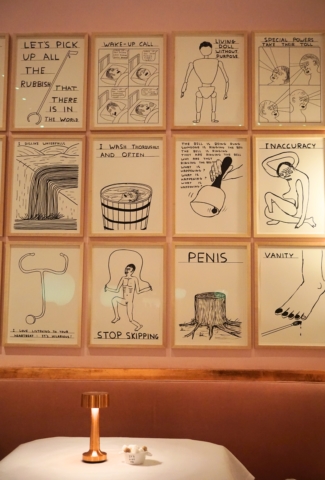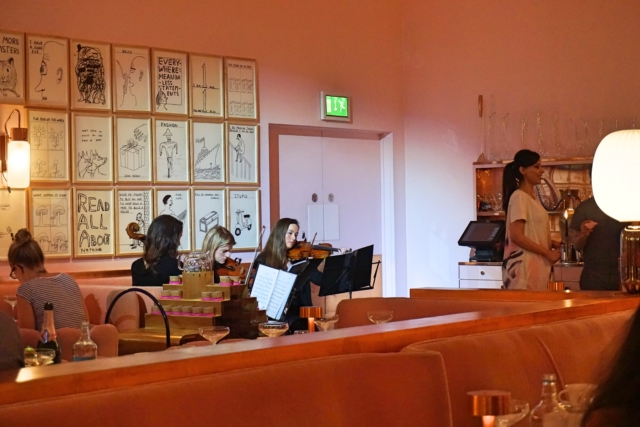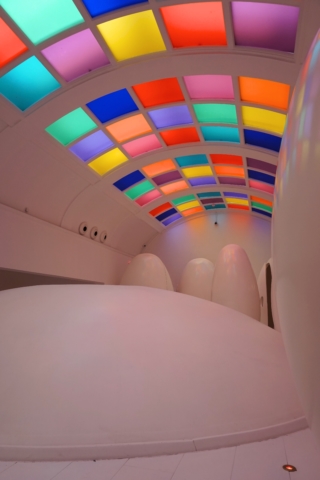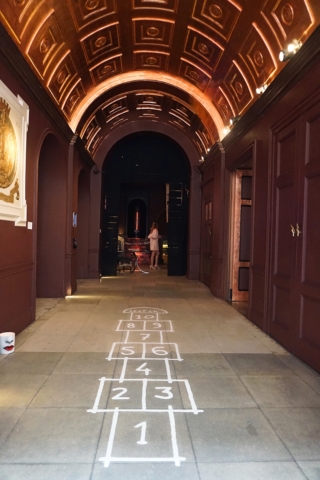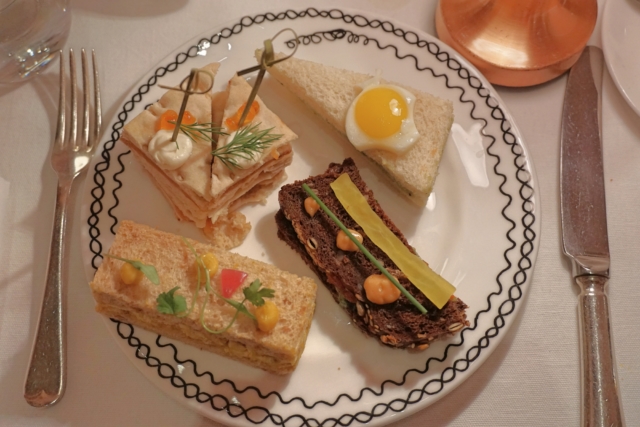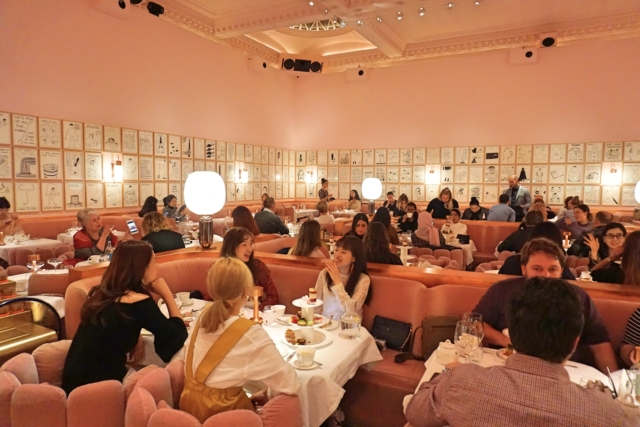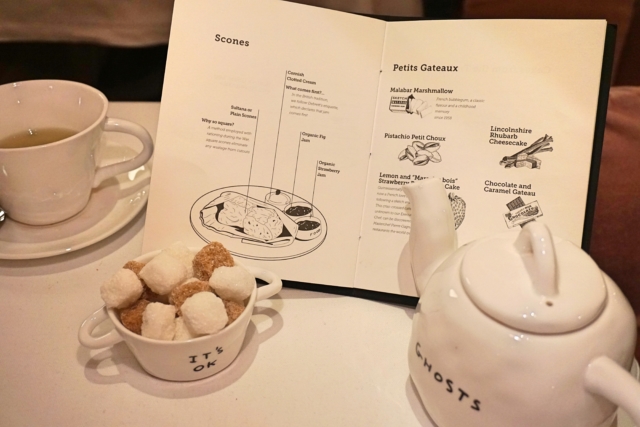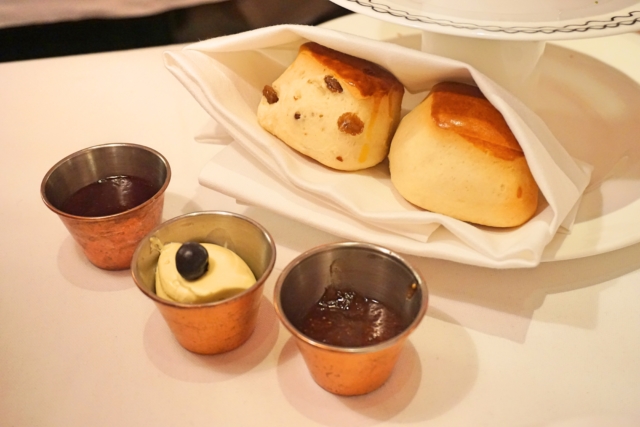sketch, with a lower-case, becomes a world of wonders as soon as you enter the building. It invites you to let go of your adult worries, and become a child yet again, immersed in the rustling leaves of a dense jungle, and the glamour of a grand tearoom entirely dressed in pink, with men in boiler suits, a tea master, and the caviar man at your service. The hopscotch greeting you at the floor of the entrance hall is only a hint at what’s to come. Be prepared for not just tea and food, but for an enveloping experience that includes everything from quirkiness in decoration to pure style in performance.
sketch is the brainchild of French master chef Pierre Gagnaire and renowned restaurateur Mourad Mazouz. It spans two expansive floors of a converted 18th-century building on Conduit Street in Mayfair, London. No less than five rooms have been redesigned and turned into restaurants and bars, including the Lecture Room, a sophisticated Michelin star dining room, the Glade, an enchanted forest with woodland bar for breakfast, brunch and cocktails, and the Gallery, which aside from offering dinner is also the venue for the famed afternoon tea.
Mazouz has not only opened multiple acclaimed restaurants and bars in cities such as Paris and Dubai, but he has also published his own The Momo Cook Book and founded the Mo’Zik record label. Michelin-star chef Gagnaire has been equally influential and adventurous in his cooking, receiving worldwide recognition for his restaurants in Paris, Dubai, Las Vegas, Hong Kong, Tokyo, and Seoul.
It comes as no surprise then, that these two souls would come together to launch a destination place for food, art and music, providing venues for artists such as Turner Prize-nominated David Shrigley to not only display their artworks to visitors, but to add to and enhance the space, creating an afternoon tea experience like no other. Since sketch’s inauguration in 2002 the venue has hosted over fifty exhibitions of artists’ moving image. More than simply a building to house restaurants in, it is a platform for artists’ imaginings and innovations in art, design and social space, allowing for an interaction with art in the public realm.
In 2014 Shrigley’s work was installed in the newly-refurbished Gallery. With 239 works lining the room’s walls, it is the largest group of original drawings Shrigley has ever exhibited. If you step inside and you’re wondering where you might haven seen his work before, there’s a good chance it was at Trafalgar Square, where his “Really Good” 10-metre tall bronze ‘thumbs up’ sculpture featuring a jovially elongated thumb has been sitting on top the fourth plinth since September 2016.
Just in case you’re wondering what the Fourth Plinth Commission is, here’s a quick lowdown. The Fourth Plinth is the northwest socle in Central London’s Trafalgar Square, which was originally intended to hold an equestrian statue of William IV, but due to insufficient funds remained bare. For no less than one and a half centuries, the future of the plinth was debated, then temporary projects instigated, until in 2003 the ownership of Trafalgar Square was transferred from Westminster City Council to the Mayor of London, marking the beginning of the Mayor of London’s Fourth Plinth Commission with a total of eight commissions to date, each lasting between one and two years. If you’re interested in finding out more, you can visit their official website here.
As for Shrigley’s works at sketch? Much like his thumbs-up statue, they become so much more than simply oeuvres to look up at. The distance one would experience in an art gallery between a work and oneself has been obliterated. The cartoon-like drawings filling the walls have become so much part of the space that it changes our experience of the afternoon tea event altogether.
It’s one of the beauties of public or semi-public art, this subconscious transformation of the way we feel about and interact with a space. Shrigley’s artwork touches us at exactly this subconscious level, but it also provokes and humours us, challenges our common perceptions. The drawings, which make satirical comments on human interactions and everyday situations, are only a part of this. We have one drawing depicting a cut-off tree trunk labeled as “penis,” another describing two oval shapes as potatoes when really they could be anything.
The second part to Shrigley’s presence in the room finds itself right on our tables. Through his collaboration with British manufacturer and heritage brand Caverswall, the dining table and ceramic tableware at the sketch Gallery become functional artworks, presenting food and drinks that in their composition and creativeness are as much a piece of art as anything else.
The tableware is, Shrigley reflects, “the first artwork that I have made that can go in the dishwasher.” Finding your sugar bowl labeled as “it’s not ok” will certainly make anyone think twice to reach for a cube. But worry not, because Shrigley offers a simple solution: just turn it around by 180 degrees and it’ll tell you that “it’s ok.” Problem solved. And if your teapot is filled with ghosts, as Shrigley seems to describe (you may have another interpretation), is this a gentle warning to you not to bring up any ghosts of your past in the small talk afternoon tea conversation you’re about to hold? Perhaps a plausible theory, given that the tea cups say nothing other than “forget about it.”
Paris-based architect and designer India Mahdavi was the one to refurbish the Gallery as a backdrop for Shrigley’s artwork. In contrast with the playful and provocative texts and drawings, Mahdavi conceived a much more soothing and monochromatic all-pink interior, with velvet-covered custom-made furniture, harmonizing the humour and wit in Shrigley’s creations with a certain elegant and muted finesse in the furnishing and decoration. And it works brilliantly. It turns sketch into not just another posh venue, but a world all its own that exists nowhere else. For two hours (or three, as we almost ended up staying), you are not at an afternoon tea in London. You are in a curious world with alien toilets, story-like characters (the caviar man!) and a high-society ambience which Shrigley, almost as if present, takes apart.
Yes, the toilets, they deserve a mention here. Egg-shaped cubicles are spread out across a large room with high ceilings which you can reach from an open staircase splitting in two ways. You might expect to find women’s toilets on the left, and men’s on the right or vice versa, but it’s a mixed sex affair – the two symmetrical spaces are not separated in any way. It’s a surreal experience, public yet very private at the same time.
Once you step inside that cubicle, it’s as if you’re about to take off and start your journey to yet another world, or perhaps as if you’re already on your way there (think small-spaced airplane toilets). You step out and you find yourself in a strange deserted land, bathed in all the colours of the rainbow (the coloured glass ceiling plays beautifully with the light), echo-y and ungraspable. You feel disoriented and you grab your phone to take a picture for your friends and followers to see, trying to capture and communicate the strangeness of it all. Then you walk back into the eerily elegant tea room with a string trio playing beautiful, calm and soothing classical tunes.
The caviar man whooshes through the room and you notice all the other costumes. The final touch, the icing on the cake at sketch afternoon tea are indeed the uniforms worn by staff, turning them into characters part of a play in which visitors are encouraged to take part. We choose our tea with the help of the Tea Master, or we have our champagne popped (if we select the bubbly option) by none other than the Cork Popper. The outfits were developed by fashion designer Richard Nicoll and include T-shirt dress silhouettes for the waitresses – the Ladies with Dots; smart, grey boiler suits for the waiters – the Men in Grey; and a muted pink suit for the Caviar Man.
But wait, I haven’t even mentioned the food yet! From the caviar with Comté cheese and 63° egg yolk start, to the cakes served from a trolley at the end, the afternoon tea and food journey was a lavish affair. The menu continued the playful and witty theme Shrigley had set with his omnipresence. Sandwiches are deconstructed and explained in drawings depicting the several layers. The pastries, or petits gateaux as they are referred to on the menu, are elucidated in a brief text and a drawing each of their most prominent ingredient. If the tea is what draws you to afternoon tea, you won’t be disappointed. The four-page tea list with extensive descriptions can satisfy any tea aficionado.
Indeed, the tea collection offered at sketch spans camellia sinensis leaves from all over the world (with China heavily represented) and covers all types of teas from white to black. We tried the sketch Special Blend, a wonderfully fruity black tea with notes of chocolate, dark berries, ginger, and caramel. We also had the Iron Buddha, an immensely floral oolong underpinned by tart freshness. Both went well with the sweet petits gateaux and British-style cakes.
The green teas we tried and enjoyed with our sandwiches were the Phoenix Honey Orchid from China, a fruity, honeyed liquid concoction produced from elegantly long, twisted leaves; as well as the Sichuan Dew with a thicker texture and rich umami flavour. They were top-notch without fault and I would have loved to revel in all thirty of them, except that my belly was about to burst, despite several visits to the strange alien land with the egg-shaped capsules.
The sandwiches, one more exciting than the other, consisted of three classics: corn-fed coronation chicken, Scottish smoked salmon with sour cream, and egg plus mayonnaise, although a goose egg was used. The final fourth one, Igor, was inspired by master chef Gagnaire’s pet dog of the same name, who is always on the look out to snap up any of this sandwich’s included ingredients: daikon, chives, tomato chutney, lettuce, homemade mayonnaise and pumpernickel bread. Kudos to Gagnaire who conceived it, but also to executive chefs Johannes Nuding and Hervé Deville who execute it every day.
As for the sweet treats? The complexity yet lightness and delicacy typically found in French pastries was overflowing in Gagnaire’s petits gateaux. Think soft chocolate caramel gateaus with a crunchy base and fluffy pistachio petit choux. Jams were succulent and organic, and scones freshly served with the airy yet slightly crumbly texture they are meant to have.
If there’s a special occasion coming up or if you simply can’t wait to try out this magical sketch production of elegance combined with wittiness, rest assured, it will be an afternoon to remember. sketch afternoon tea is not simply a light meal with a drink or two. It’s a ritual, a ceremony in many acts in a strangely bizarre yet alluring world. As artist Shrigley himself encourages: “Enter this place with an open mind. Imagine, if you will, a painting that never dries.” The performance never ends. And neither does the enjoyment.
Area: Mayfair, Central London
Closest tube: Oxford Circus (Central and Victoria line); Bond Street (Central and Jubilee line); Piccadilly Circus (Piccadilly line)
Address: sketch
9 Conduit Street
London W1S 2XG
Website: http://sketch.london/afternoon_tea.php



